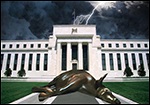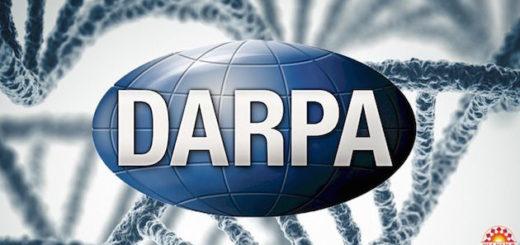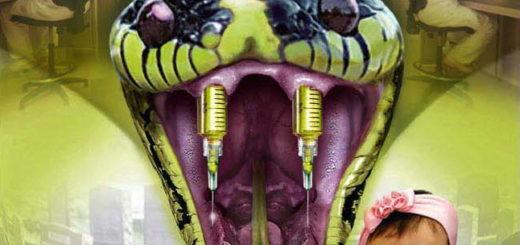Wall Street Banks Proven Threat to America’s Economic Survival-Call Congress 202-224-3121 & Demand Glass-Steagall To Rein In These Deadly ZIONIST Banksters!
Shhh! Don’t Tell the Fed these Wall Street Banks Have Tanked 34 to 48 Percent Year-to-Date. (The Fed Thinks They’re a “Source of Strength”)
By Pam Martens and Russ Martens: September 24, 2020 ~
Federal Reserve Chairman Jerome Powell’s oft repeated mantra this year – that the behemoth Wall Street banks “are a source of strength” in this economic crisis – is melting away faster than a snow cone in July, along with the share prices of these banks. So whom should Americans believe: The composite wisdom of the market or the opinion of a federal regulator whose supervision of these banks has been far from stellar.
The market would seem to have spoken clearly on just how “strong” these banks are. Since the first trading day of the year, January 2, to yesterday’s closing price, here’s the factual reality of just how much common equity capital these banks have bled: Citigroup is down a stunning 48 percent, losing almost half of its common equity capital; Bank of America has lost 35 percent; while JPMorgan Chase, the bank that has perpetually bragged about its “fortress balance sheet,” is down 34 percent year-to-date. And the U.S. is only seven months into what could become a prolonged economic downturn.
The reason Powell has to tippy toe around the Wall Street mega banks’ condition is because, as of June 30 according to the Federal Deposit Insurance Corporation (FDIC), Citigroup is sitting on $1.2 trillion of deposits, of which half are foreign and might take flight; Bank of America is sitting on $1.8 trillion in deposits, of which 94 percent are U.S. based; and JPMorgan Chase holds $2 trillion in deposits, of which $1.7 trillion or 85 percent are U.S. based.
As of September 10, the FDIC reports that the U.S. had 5,059 federally insured institutions including banks and savings associations. The three banks named above are holding 30 percent of all deposits held by all 5,059 federally insured financial institutions in the U.S. while representing just 0.059 percent of the number of federally insured institutions.
The 5,059 banks we have today is less than half of the 10,220 banks and savings associations that were federally insured at the end of 1999 – the year that the Bill Clinton administration passed the Gramm-Leach-Bliley Act that repealed the 1933 Glass-Steagall Act. The repeal of the Glass-Steagall Act, which had protected the U.S. financial system brilliantly for 66 years, meant that Wall Street’s casino investment banks were now unleashed to gobble up federally insured banks. And gobble them up is exactly what they did.
By the end of 2005, six years after the Clinton administration had repealed the Glass-Steagall Act, the U.S. was down to 8,832 federally insured banking institutions. By 2010, the number of U.S. banking institutions had dropped to 7,657 with 197 institutions absorbed that year through mergers. In years 2015, 2016 and 2017, there were a total of 786 federally insured banking institutions absorbed through mergers.
And exactly who was it that was allowing all of these bank mergers to occur and dangerously concentrate banking in the United States into the hands of a few dangerous mega banks with wild trading operations? It was – wait for it – Jerome Powell’s own Federal Reserve.
In conjunction with a December 4 hearing by the House Financial Services Committee, it issued a Memorandum outlining some of its key concerns. One eyepopping paragraph in the Memorandum revealed that for more than a decade the Federal Reserve had not rejected even one bank merger application. It noted this:
“Concerns have been raised about federal financial regulators rubber stamping prior merger and acquisition applications. For example, based on data provided by the Federal Reserve, from January 1, 2006 through December 31, 2017, over 3,800 merger applications were submitted to the agency. During this eleven-year period, however, the Federal Reserve did not reject any merger application. On November 20, the Federal Reserve and FDIC granted approval of the merger between BB&T and SunTrust, creating the sixth-largest bank in the United States.”
The safety and soundness of the U.S. financial system requires that banks that are sitting on more than $1 trillion in deposits not be highly-interconnected; not have tens of trillions of dollars in dangerous derivatives; not be holding trillions of dollars off their balance sheet; not be engaging in criminal activity; and are broken up when they show a serial pattern of wrongdoing. Jerome Powell’s Fed has failed to enforce every single one of those common sense rules when it comes to JPMorgan Chase and Citigroup.
JPMorgan Chase has pleaded guilty to three criminal felony counts since 2014. Yesterday, Bloomberg News reported that the bank may pay close to $1 billion to resolve charges by federal regulators that “traders on JPMorgan’s precious metals and treasuries desks rigged markets.” The article also delicately mentions in the sixth paragraph that “It is anticipated that JPMorgan will admit to wrongdoing.” Seriously? Where are the criminal charges?
This is a three-count admitted felon that is, apparently, now messing with the debt issued by the United States government, i.e., U.S. Treasury securities.
On top of that, the U.S. Department of Justice had already criminally charged three of JPMorgan’s precious metals traders under the Racketeer Influenced and Corrupt Organizations Act or RICO. According to the Justice Department, the traders engaged in a pattern of rigging the gold, silver and other precious metals markets from approximately May 2008 to August 2016. One of the traders, Michael Nowak, was actually a Managing Director at the bank and the head of its Global Precious Metals Desk. The other two traders are Gregg Smith and Christopher Jordan.
RICO is typically used to indict members of organized crime syndicates. Which brings to mind that in their 2016 book, JPMadoff: The Unholy Alliance Between America’s Biggest Bank and America’s Biggest Crook, veteran trial lawyers Helen Davis Chaitman and Lance Gotthoffer actually recommended that JPMorgan Chase be charged under the RICO statute. They wrote:
“If Jamie Dimon is running a criminal institution, he should be prosecuted for it. And law enforcement has the perfect tool for such a prosecution: the Racketeer Influenced and Corrupt Organizations ACT (RICO).
“Congress enacted RICO in 1970 in order to give law enforcement the statutory tools it needed to prosecute the people who committed crimes upon orders from mob leaders and the mob leaders themselves. RICO targets organizations called ‘racketeering enterprises’ that engage in a ‘pattern’ of criminal activity, as well as the individuals who derive profits from such enterprises. For example, under RICO, a mob leader who passed down an order for an underling to commit a serious crime could be held liable for being part of a racketeering enterprise. He would be subject to imprisonment for up to twenty years per racketeering count and to disgorgement of the profits he realized from the enterprise and any interest he acquired in any business gained through a pattern of ‘racketeering activity.’ ”
Is there a “pattern” to charge the bank itself under RICO? Consider this small sampling of charges brought against JPMorgan Chase while Jamie Dimon has sat at the helm:
In 2014 the U.S. Department of Justice charged the bank with two felony counts for its role in the Bernie Madoff Ponzi scheme. The bank put in writing to U.K. regulators that it suspected Madoff was running a Ponzi scheme but failed to report it to U.S. regulators. The bank allowed tens of millions of dollars to be laundered through the Madoff business bank account it maintained for decades. The bank pleaded guilty to the two felony counts but no individual was charged at the bank. The bank was given a three-year probation and handed a deferred prosecution agreement.
In 2015, the bank was charged with another felony for its role in rigging foreign currency trading. It also admitted to that felony charge and was given a deferred prosecution agreement. Its probation period for the foreign currency charge just ended in January of this year and now we hear that the Justice Department is ready to settle new charges that certainly sound like they are of a criminal nature.
Here’s more of the pattern:
In October 2012, JPMorgan Chase paid $1.2 billion to settle claims that it, along with other banks, conspired to set the price of credit and debit card interchange fees.
In September 2013, JPMorgan Chase agreed to pay $80 million in fines and $309 million in refunds to customers whom the Bank billed for credit monitoring services that the Bank never provided.
On November 15, 2013, JPMorgan Chase announced that it had agreed to pay $4.5 billion to settle claims that it defrauded investors in mortgage-backed securities in the time period between 2005—2008.
On December 13, 2013, JPMorgan Chase agreed to pay 79.9 million Euros to settle claims of the European Commission relating to illegal rigging of benchmark interest rates.
In July 2013, JPMorgan Chase paid $410 million to the Federal Energy Regulatory Commission to settle claims of bidding manipulation of California and Midwest electricity markets.
On November 19, 2013, JPMorgan Chase agreed to pay $13 billion to settle claims by the Department of Justice, the FDIC, the Federal Housing Finance Agency, the States of California, Delaware, Illinois, Massachusetts and New York, and to consumers, relating to fraudulent practices with respect to mortgage-backed securities.
If you want to stop the pillaging of the United States, call your Senators and House Reps today and demand that they restore the Glass-Steagall Act and break up these dangerous banks.
Related Articles:
3-Count Felon, JPMorgan Chase, Caught Laundering More Dirty Money
It’s Official: JPMorgan Chase Is the Riskiest Big Bank in the U.S.FacebookTwitterEmail
Comment: Rothschild Khazarian/ZIONIST Mafia run Federal Reserve Banks and Wall Street. British Royals and Empire are a ZIONIST cabal.














